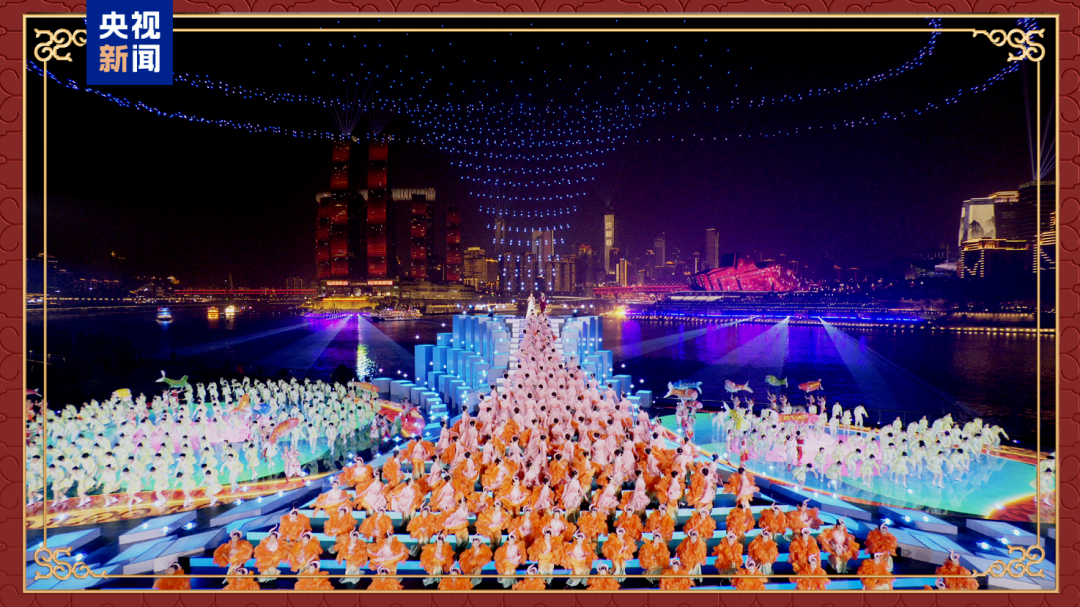 Bridging News
Bridging News
Extended Holidays, Trade-In Incentives Drive Spring Festival Shopping Surge | Insights
Chongqing - The inclusion of the Chinese New Year on UNESCO's Intangible Cultural Heritage List made the Year of the Snake special, as the holiday was extended to eight days from Jaunary 28 to February 4. By the end of the holiday, consumption in Southwest China's Chongqing Municipality had risen by 9.6%.
This year is especially significant for Chongqing, as the city hosted a sub-venue for the CCTV Spring Festival Gala for the first time. National trade-in policies boosted consumer spending, signaling a strong economic recovery, said Li Ling, deputy director of the Institute of History and Culture at Chongqing Academy of Social Sciences, on February 5.

The Chongqing sub-venue of the CCTV Spring Festival Gala. (Graphic/CCTV)

A flash event was held in the Guanyinqiao business district in Jiangbei District, Chongqing. (Photo/Jiangbei District)
"We came here after watching the Spring Festival Gala, and the night view of Chongqing is truly impressive," said Wang Xiao, a visitor from Wuhan, as he marveled at the dazzling night view of the two rivers while aboard the Changhang Chaotian Xinghe cruise ship on February 3.
"We have extended the night cruise operation hours from 9:00 PM to 10:40 PM to meet the tourism demands of visitors," said a representative from the China Yangtze River Shipping Corporation. The average daily passenger flow for night cruises has increased by 10.6% compared to last year.
Li highlighted that the Chongqing Spring Festival Gala sub-venue has become a global marketing event. The addition of check-in spots and nighttime drone shows has turned Nanbin Road, Yuzhong Peninsula, and Jiangbeizui CBD into major consumer hotspots, drawing tourists for shopping and sightseeing.

The cityview of Yuzhong District, Chongqing. (Photo/Yuzhong District)
Boosted by new cross-border travel policies, Chongqing is seeing a 112% year-on-year increase in inbound tour orders during the spring festival, according to Ctrip.
"The eight-day holiday allowed for multi-segment trips. Chinese people traveling overseas for Chinese New Year and foreigners visiting China to celebrate created a two-way travel boom," said Zhou Huijie, an industry analyst at Ctrip Research Institute.
This year’s holiday saw a rise in family outings and cultural heritage experiences, with lantern viewing, temple visits, Chinese costume wear, and fireworks taking center stage. Fliggy data shows a 36% increase in tourist spending on trips featuring folkloric performances compared to last year.
"The unique customs and traditions of Northeast and Southeast Chongqing have led many residents to opt for celebrating the Spring Festival in their districts and counties instead of heading to Hainan for the winter," said Li. "Themed homestays showcasing local culture have become a top choice for holidaymakers and are still in high demand."

During the Spring Festival, Meixin Wine Town held festive folk cultural activities. (Photo/Meixin Wine Town)
"From New Year's Eve to the sixth day of the Lunar New Year, we welcomed over 420,000 visitors," said a spokesperson for Meixin Wine Town in Fuling District, Chongqing. The venue hosted various folk activities, including Dragon Flying, Firework Shows, and the Lantern Festival.
Furthermore, driven by the trade-in subsidy policy, businesses across Chongqing launched discount campaigns, leading to a continued surge in sales of home appliances, automobiles, and digital products.

At the JD Super Experience Store, customers are lining up to check out. (Photo/JD Super Experience Store)
"Popular products sold out quickly, but we are registering customers and will notify them as soon as the goods are back in stock," said staff at JD Super Experience Store in Chongqing Liangjiang New Area.
In the first seven days of the Spring Festival, Chongqing’s digital product subsidy policy drove 165,400 transactions and 488 million yuan (approx. 67 million USD) in sales. Mobile phones from Huawei, Xiaomi, and Apple saw sales rise 3 to 5 times compared to pre-festival levels, highlighting strong market demand.
Li further noted that in Chongqing's northeast and southeast mountainous regions, migrant workers returning home took advantage of the eight-day holiday to trade in old home appliances and digital products, further boosting the market's consumer activity.
 Related Stories
Related Stories